The current state of barebow risers on the market. By Andreas Philipp.
In principle, every take-down recurve riser can be shot as a barebow, but you often hear and read the question of a suitable riser for a beginner or an intermediate.
Risers specifically designed for barebow have some advantages. According to World Archery rules, a barebow has to be shot without any stabilizers, sights or other additions and has to fit through a ring with a diameter of 122mm. The only items allowed for adding stability to the bow are weights. If you have shot a normal recurve bow without any weights, you know that it will not stay in your hands on release and the upper part will usually jump backwards.
Dedicated barebow risers try to eliminate that by shifting the center of gravity downwards. Some risers are already manufactured with more mass in the lower half. Alternatively, there is often the possibility to build weight directly into the riser, plus enabling the archer to add additional external weights, so that everyone can tune their bow in the way they like it best. The aim is to have the bow react as calmly as possible, to gain maximum control and precision.
As almost every recurve riser can serve as a barebow, at tournaments, you can see a wide variety of setups, with Hoyt, SF/WNS or Win & Win risers not uncommon. A very common riser for beginners as well as advanced archers is the SF Forged+, not an ‘official’ barebow riser at all, but easy to configure and at a reasonable price. In my first year as a barebow shooter, I shot a SF Forged+. I was very happy with that – at least, until I discovered the “real” barebow risers.
As you might expect, you can buy barebow risers in almost every price category from around £200 up to £1000. In this article, we will take a look at commonly used risers, but will also mention a couple of exotic and legendary risers. The golden rule also applies here: there is not a ‘best’ riser. The best riser is the one which best suits the archer.
For beginners: Risers under £300
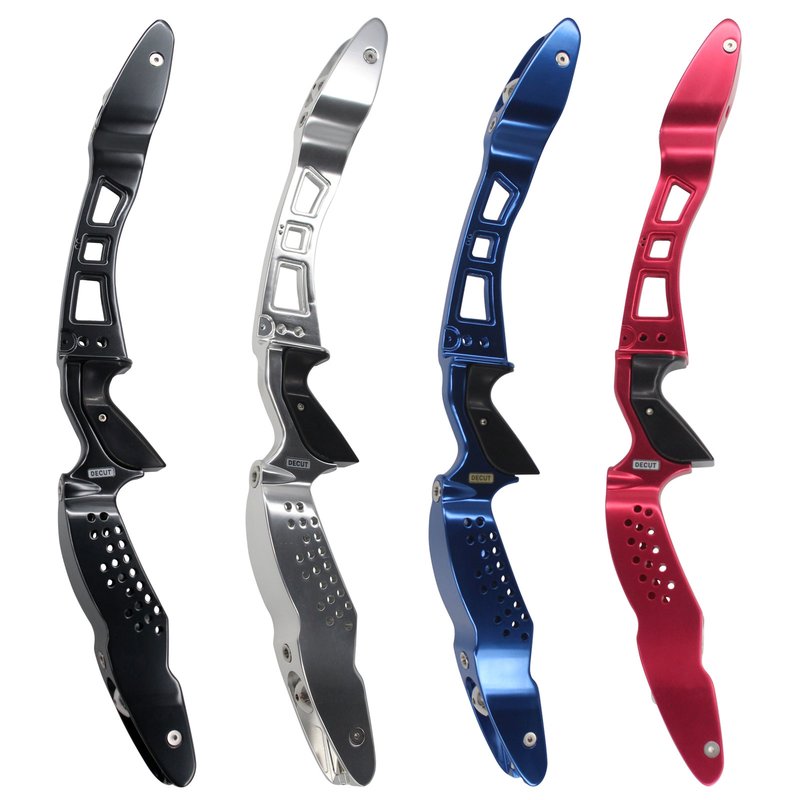
The currently cheapest mere barebow riser is the Decut Rhino at around £200. Like all risers we will discuss in this article, it is an ILF riser with a length of 25” inches, and thus suited with the appropriate limbs to make a bow from 66 to 70 inches. The Rhino is available for right-handed and left-handed archers. Considering the bulky lower part, you could say a bit of elegance is missing, but for this price, you can’t say much about the workmanship and features.
In the recessed lower part you can insert up to three additional weights (1x 50 + 2x 100 grams). This will make the riser achieve a weight of approximately 1,700 grams, which can’t be called a lightweight. Due to the standard screw threads, you can also mount additional weights on the front. The Rhino sits stable in your hands and only slightly deflects backwards in the upper part.
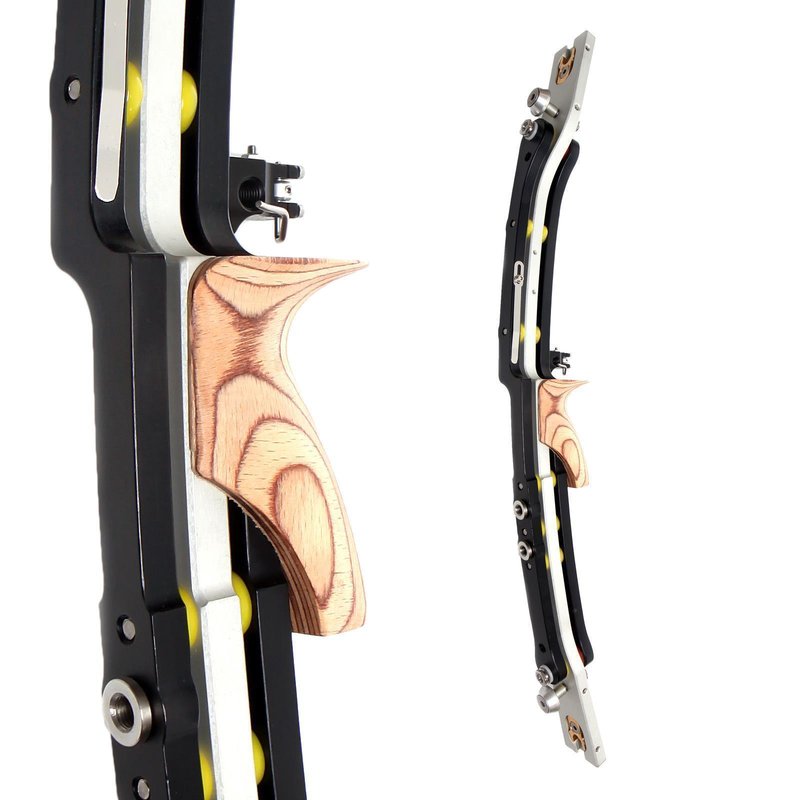
The 1350 gram Spigarelli Revolution BB25 is distinguished by an extravagant design which resembles a leaf spring – and with an interesting story to tell. Due to the design of the sight window, the original form of the riser was not allowed in the barebow category, since it could have been used as a sighting aid. Spigarelli responded quickly and launched a revised version, namely the BB25, which is currently available for a very reasonable £250 or so – although few shops have them in stock and you are likely to need to order one.
The design, consisting of three screw-mounted metal pieces with dampeners, causes the bow to be very calm, since vibrations are absorbed very well. Nevertheless, the riser also has its disadvantages. The wooden grip is not designed in an optimal way and was attached poorly on my model. In addition, it requires comparatively intensive maintenance, because the multiple fittings and bolts need to be checked regularly.
Personally, I was not quite happy with this riser. According to the construction, only the SPIGA Z/T Zero Magnetic arrow rest fits to the riser. But while doing stringwalking, the finger of the rest broke frequently. On the other hand, I had the feeling that there was too much dynamics in the whole system, particularly combined with fast limbs like Uukhas. In addition, I read stories in forums saying that with higher draw weights it sometimes did happen that the riser got broken. But beginners and intermediate archers with a low draw weight might really like it.
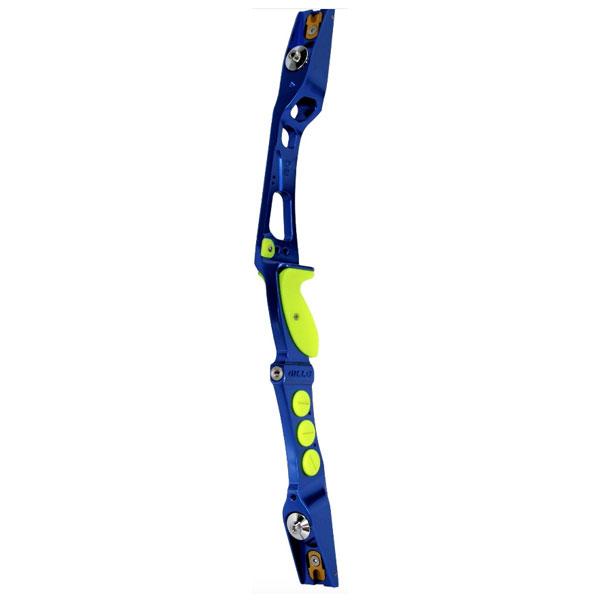
Perhaps the best option in the sub-£300 range £300 is the Gillo G2. Its big brother, the G1, currently ranks upon the most popular barebow risers, and when it comes to quality, the G2 is also on a high level. The right-hand 25” riser is 1,240 grams (without weights) and it is perfectly suited for beginners. Up to three internal weights can be added to the lower part, and there are different weights and colour cover options. Additional weights can be added at the two front and another bushing at the back. The yellow grip made of plastic is a matter of taste, but there are many alternatives to replace it.
The medium class: £300 to £600
In the medium price category, the range of barebow risers is quite diverse, with Italian manufacturers like Bernardini, Gillo, Spigarelli or Best performing well.
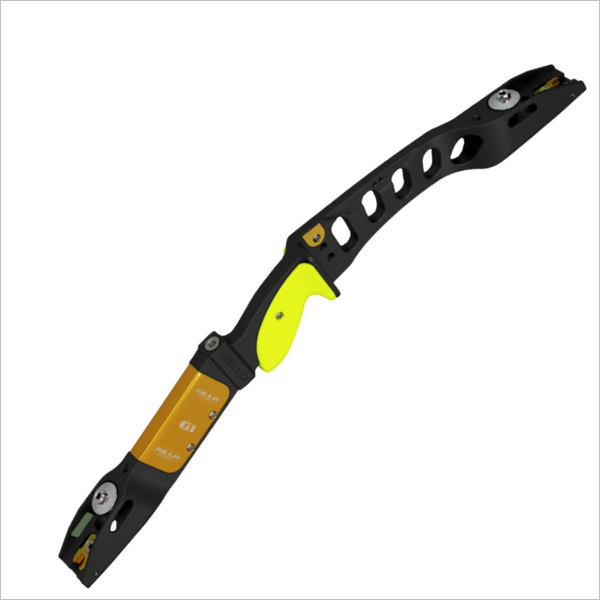
The Gillo G1 is perhaps now the uncrowned king of barebow risers. The Italian manufacturer enjoys great popularity among stringwalkers and is used by many international archers at the highest level. For around 400 euros you will get a high-quality riser with many mounting options and also plenty of accessories like weights, grips and covers. It is available for right-handed as well as for left-handed archers and in lengths of 25 and 27 inches. With the right limbs, like the Uukha VX+, you can build bows with a length up to 74 inches – ideal for archers with a very long draw.
Without any weights, the king of the risers weighs a moderate 1340 grams and is well-balanced already. You can insert weights directly into the riser and like the G2, those can be furnished with fancy covers. In addition, there are many sockets at the front and back for external weights. Different grips are available directly from Gillo as well as various third-party manufacturers such as Jäger Archery. In terms of tuning and value for money, the G1 is currently hard to beat. Another major plus is that almost every dealer with a good stock usually has one available.
Gillo have also just brought out a new riser, the GT, which they claim is an all-rounder. We will see if the barebow community agrees.
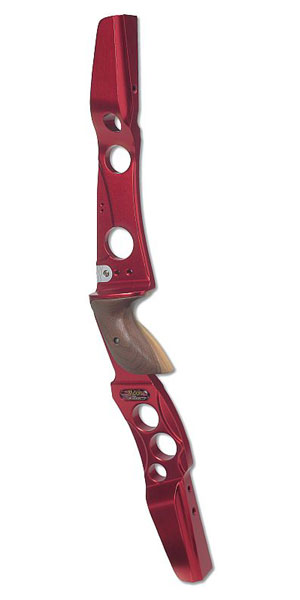
There are also several Italian alternatives, which are not to be sniffed at. The Best Moon is a relatively simple 25 inch ILF riser for right-handed and left-handed archers at a current price of €330 to €370. (They are easier to find on the continent, but your archery dealer should be able to help you). The Best Moon possesses the holes which are typical for recurve, but also the possibility to insert two weights directly to the riser.
According to my own experience, a well-balanced 1300 gram riser acts better with a 300 or 400 gram front weight. The internal weights are more interesting for archers who are keen on heavy risers. The only weak point of the riser is a socket design which means it is impossible to align the limbs if they are not straight. The Best Zenit, with a price of approx. 100 euros more, is is a bit heavier than the Best Moon and has a slightly different weight distribution.
Some like it heavy, and for these archers, the Spigarelli Club 650 Barebow is a good choice, although it has become less popular among the fraternity recently. At a cost of approx. 380 euros, this riser has a weight of 1800 grams due to its solid lower part and an optional additional weight of 210 grams. At 25 inches, this ILF riser is available for right-handed and left-handed archers and a Spigarelli Z/T arrow rest is included in the package – if you can find a retailer.
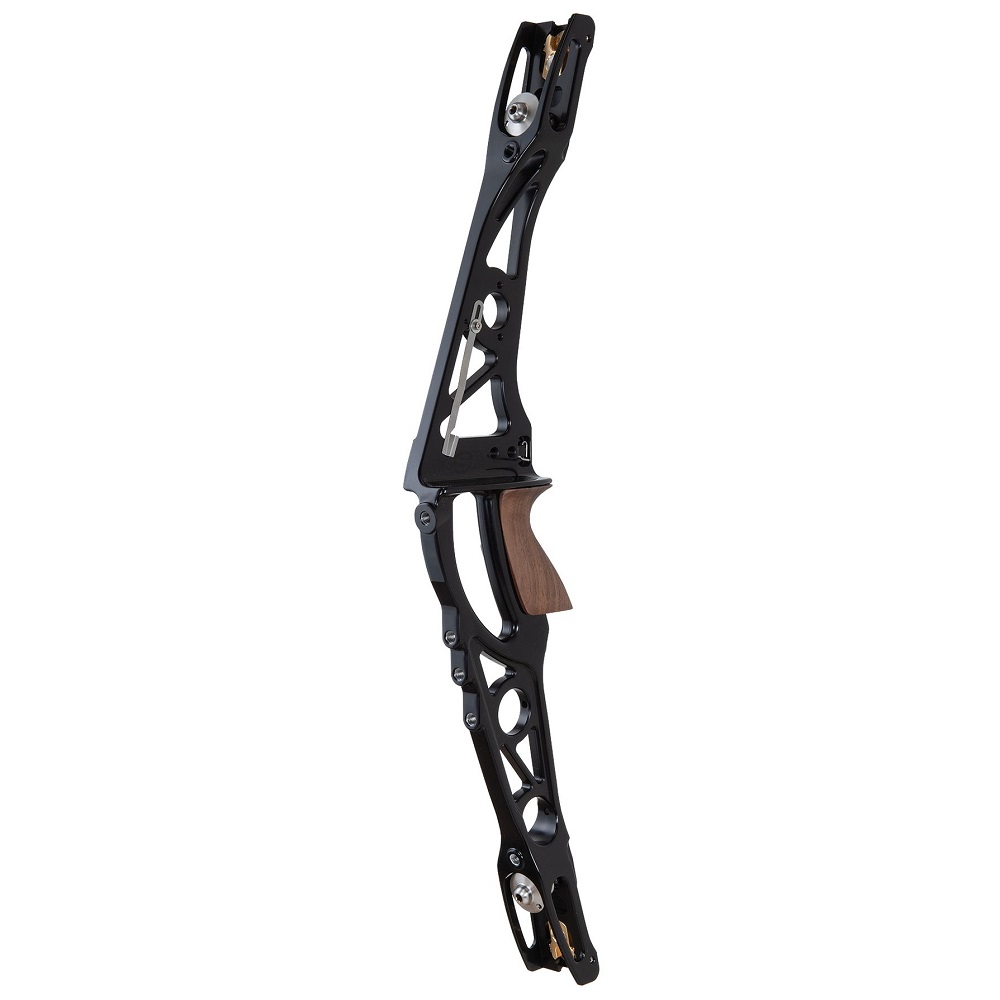
The third member of the Spigarelli barebow family is the DMS, at a cost of around €500. It immediately catches the eye: with a front-heavy braced composition, it resembles the legendary Green Horn Sirius. The extravagant design aims to count on high rigidity and, by means of the front-heavy composition, aims to create more lateral stability, by shifting the center of gravity slightly to the front.
With a weight of 1270 grams, the DMS is comparatively lightweight. But it contains numerous holes for additional weights, although one has to pay careful attention to the rule on a barebow fitting through a ring of 12.2cm, although it has been reworked to abide by this rule. Similar to the Club 650, two weights can also be inserted into the round recesses of the riser.
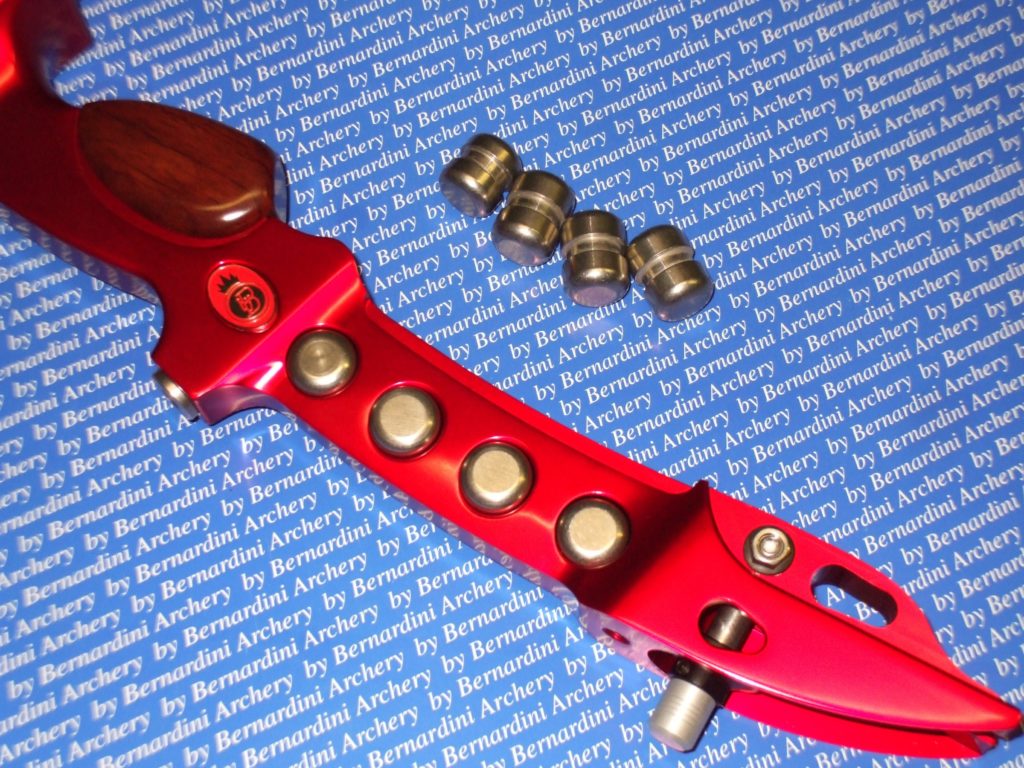
Staying in Italy a bit longer, you could look at a Bernardini Nilo, a slim and elegant barebow riser, available for lefties and righties for approx £450. There is also a 23 inch model, which is especially suited for archers with a short draw. The Nilo can be fitted with three (23“) and four (25“) weights of 50 grams respectively and has standardised bushings, so that front weights can be mounted as well. The only thing odd is the small, knobbly wooden grip of the Nilo, something which really takes some getting used to.
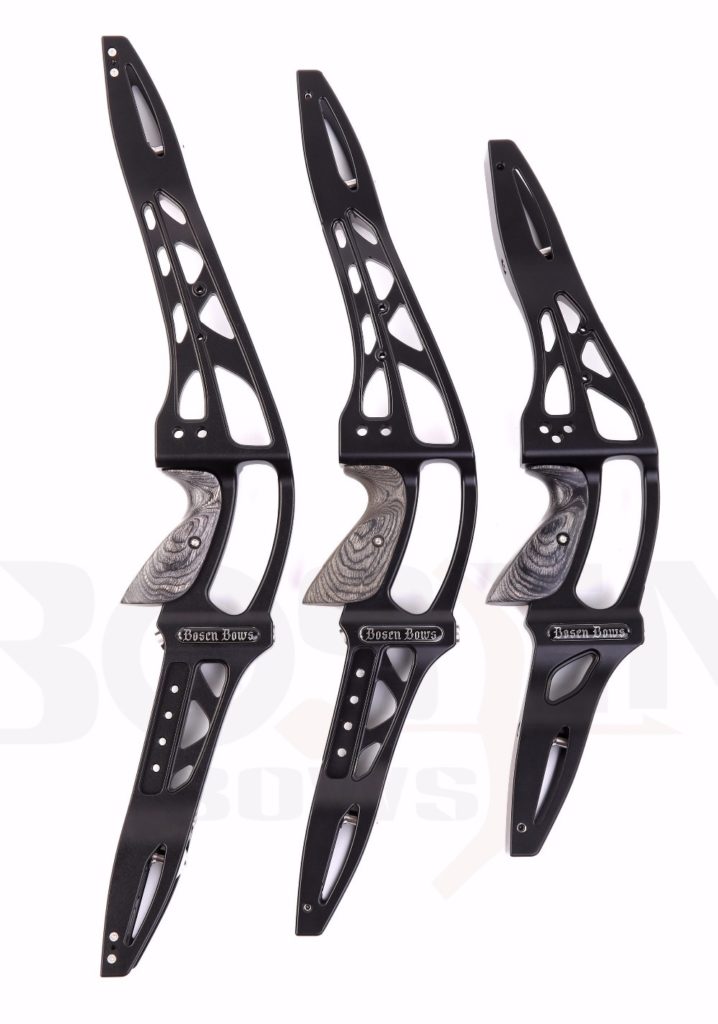
If you get excited by the futuristic forms of the Spigarelli DMS or the Green Horn Sirius, China is the market to explore. For quite some time now, Bosen Archery sells the Bosen Stronghold, which is available at approx. 400 euros via import. Basically, the Stronghold has everything a barebow riser needs, and surprisingly, it is not only for sale in 25, but also in 19 and 23 inches. I do not know whether this riser is worth the candle because so far, I haven’t had the chance to see one in real life. Brave archers are welcome to share their experience.
Luxurious and legends: risers over £600
Finally, we will look at the highest priced risers, because there are always luxury versions of things that not everybody can or wants to afford. Whether they shoot better is another question entirely.
If you like it long, keep an eye on the Bernardini Luxor. Apart from the Gillo G1, it is one of the few risers which is available in 27 inches. It somehow resembles the Nilo, but at 1440 grams, it is a lot heavier and has a different geometry. The price of around £600, however, is not cheap. Taking that into consideration, the Luxor is appropriately in the ‘exotic’ category.
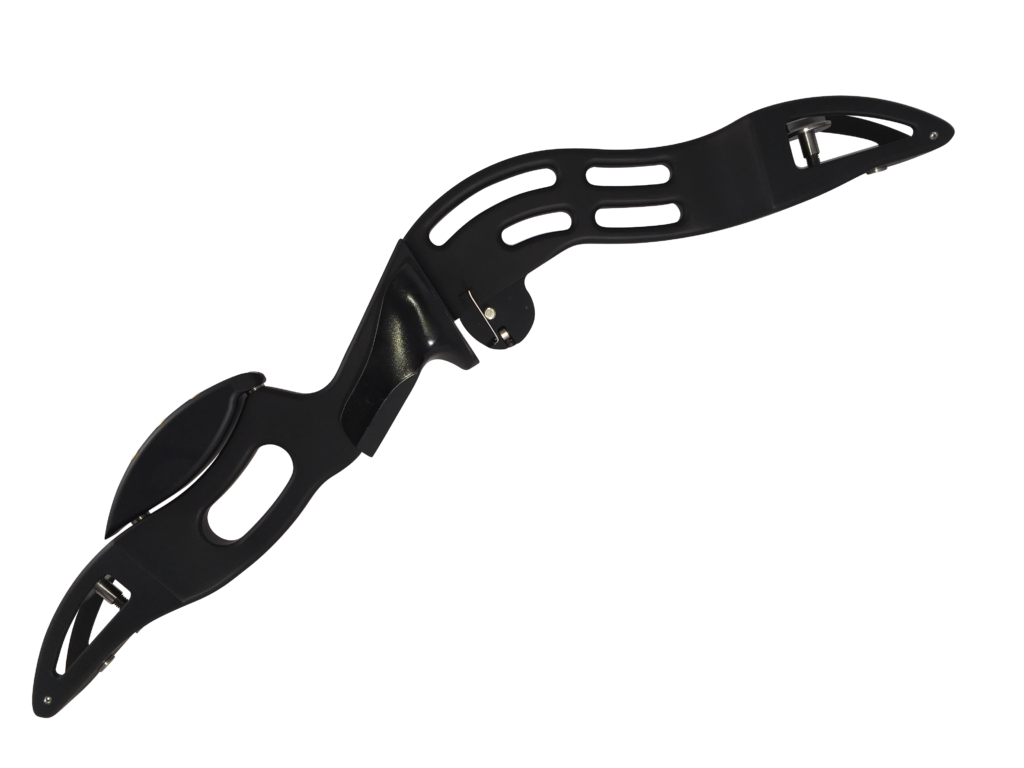
The Stolid Bull Black Thunder is a riser with proprietary limb pockets, which by now is also available also as 25 inches ILF model and costs around £700-£800. Looking at this gorgeous barebow is quite something, and it will certainly turn heads on the line. The Black Thunder is not designed for weak shoulders though, and weighs two kilos in its 25” version. The particular geometry with ‘humps’ to the front and the quite high and front-heavy position of the grip should make sure that the bow does not deflect, which can even be more intensified by additional weights.
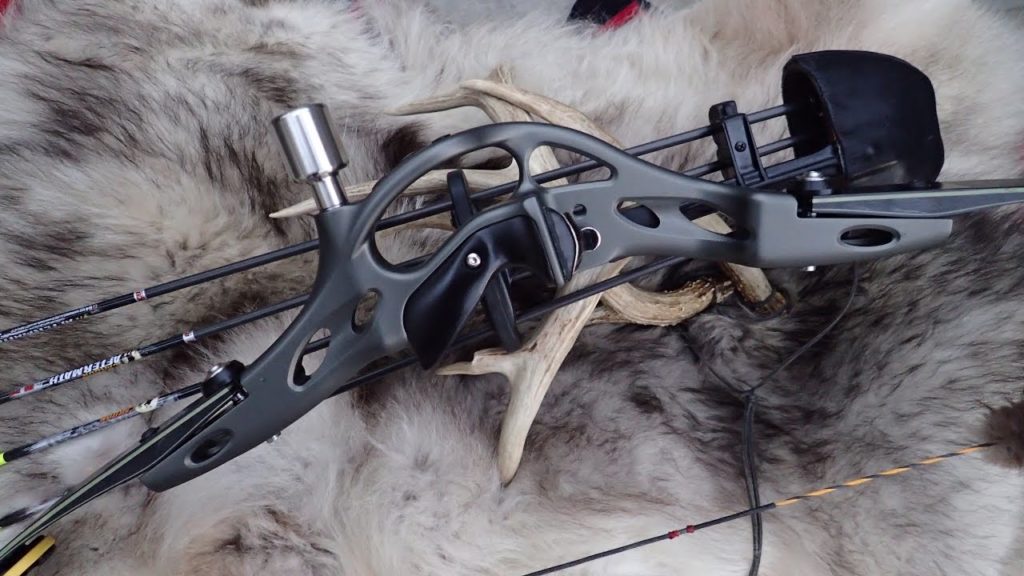
At nearly the same price, you can find the Border Tempest of the idiosyncratic Scottish manufacturer Border Bows, particularly known for their high-quality limbs. The Tempest is available in many versions from 17 to 27 inches. It is also designed with a strong front brace, to which several small weights can be mounted, to shift the centre of gravity of the bow and prevent tilt. In terms of pure looks, it a very noble piece which is extremely calm to shoot, although not easy to tune supposedly. But such a bow is perhaps best suited for experienced archers anyway.
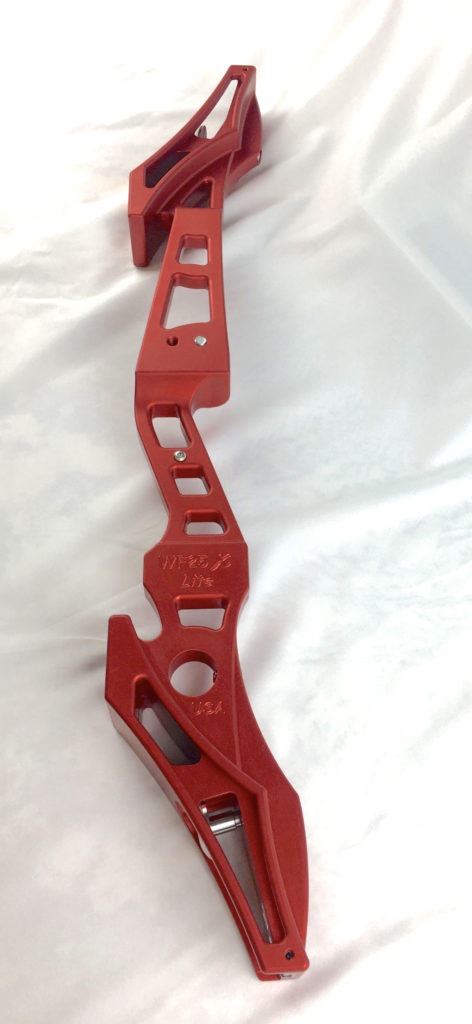
In the USA, the WF25X from CD Archery is very popular among the American fraternity – and rather expensive with a retail price of $800 before shipment, customs and tax. The distinguishing feature is the angular shape of this riser, which weighs almost two kilos, to ensure that the balance and centre of gravity is designed for shooting without stabilisers. If you believe in the experience reports from the USA, it is heavy, but at the same time extremely stable, even without any additional weights.

The South African Gray AIX, a 25 inch riser, is available at various European retailers at a cost of approx £700. At a weight of 1206 grams, this right-hand bow puts its emphasis on adjustment possibilities: with ten sockets for stabilisers, weights and the like, which makes it interesting for barebow archers who enjoy fine-tuning. Optionally, it can be upgraded with a Tec-bar, which provides for additional dampening, but also costs additional 100 euros. What is the real magic of the Gray AIX? We do not know. But it definitely sounds interesting.
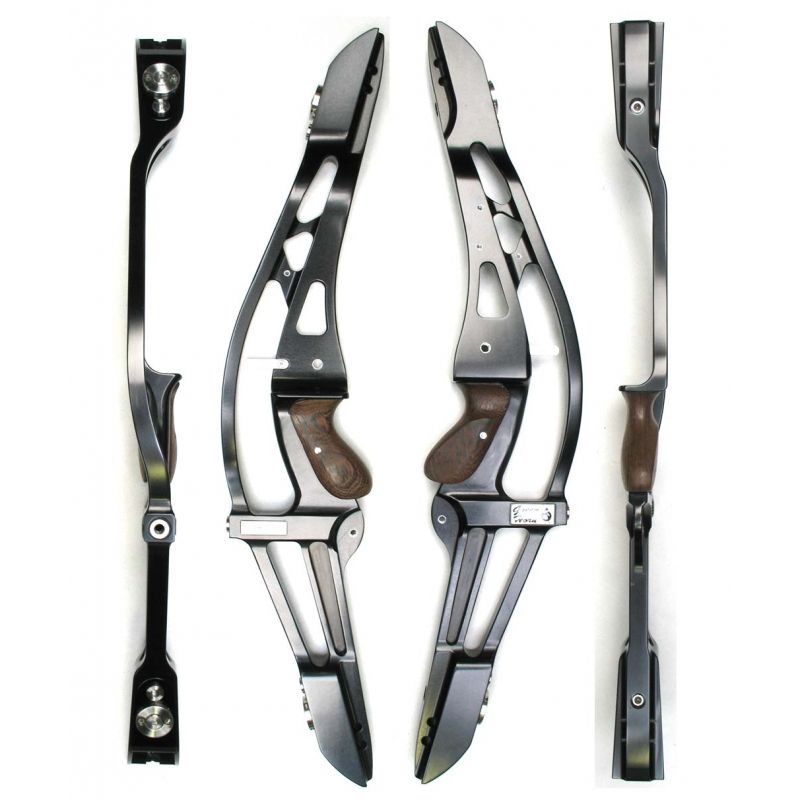
A real legend is the Belgian Greenhorn Sirius, which is no longer produced unfortunately, but nevertheless deserves a mention here. The Sirius with its front-heavy design is the role model for risers like the Spigarelli DMS or the Bosen Stronghold, but was only produced in small quantities and has become a real collector´s item in the meantime. There are only sagas and legends left of the Sirius; I am told it was extremely smooth, but when it comes to the adjustment of tiller and limbs, it was quite difficult to handle.
In Summary…
Barebow beginners can try with almost any riser – if they do not like it, they can easily go back to using stabilisers and a sight. But a purchase from this list really pays off when you are sure that barebow is the style you want to shoot. Geometry, weight distribution and mounting options make it much easier to adapt a barebow riser to one’s own needs.
The most important thing is that you chose a riser which meets your demands, with which you feel comfortable and which does not bother you. Look at the risers, have them in your hands, shoot them and if you do not enjoy them – send them back! Happy shooting.
With thanks to Bogensport and Sabrina Steffens.


“In terms of pure looks, it [the Border Tempest] is a very noble piece which is extremely calm to shoot, although not easy to tune supposedly.”
Has the author actually tested this? I have a Tempest that I’ve shot both as a barebow and as a target recurve. It is as easy as any other riser to tune. The limb bolts are easily adjustable and solid, the limb alignment system is foolproof (not that I need to use it, as my risers and limbs are all straight), and the sight window is nice and deep.
In other words, this statement doesn’t seem to be based on actual data, and it seems that other risers in this article are also not given the attention they deserve.
Hello, I shoot with the riser Bosenbows Stronghold for a year. This is only happiness, very stable, very comfortable. In addition, the weight system is “adjustable” by plate system to “stack”. The sales department is very good via Lucas Gao.
I think the role model for the DMS would have been the original DMS from the mid-90s, not the Sirius 🙂
I’m currently using a w+w inno cxt as a barebow and its a really nice riser. Although I can see the logic of a barebow riser, I would imagine the budgets that Hoyt and W+W have, you are no disadvantage using a standard riser from them.
The Gillo GT, would it not fall foul of the World Archery barebow regulations? The rubber bushing underneath the limb pocket, rather like the Fiberbow FW 21/25, can be considered a dampening system, not allowed in the barebow class. See Fiberbow’s solution to the problem, disabling part of what makes the system special. https://8fb29963-05a5-4ff0-a3c9-85f0b52c5a96.filesusr.com/ugd/fef748_e20dfe2fea8246fe8a00d2f96255ccbc.pdf
This has recently changed
22.3.6.1.
Vibration dampeners fitted as part of the bow are permitted provided that they do not have stabilisers.
Happy Days